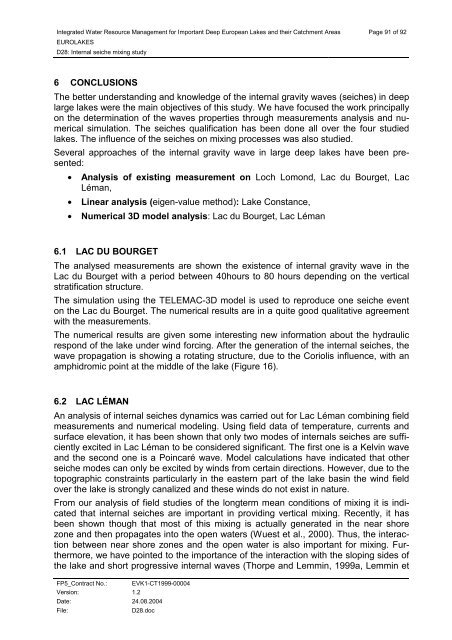D28: Internal seiche mixing study - Hydromod
D28: Internal seiche mixing study - Hydromod
D28: Internal seiche mixing study - Hydromod
Create successful ePaper yourself
Turn your PDF publications into a flip-book with our unique Google optimized e-Paper software.
Integrated Water Resource Management for Important Deep European Lakes and their Catchment Areas<br />
EUROLAKES<br />
<strong>D28</strong>: <strong>Internal</strong> <strong>seiche</strong> <strong>mixing</strong> <strong>study</strong><br />
FP5_Contract No.: EVK1-CT1999-00004<br />
Version: 1.2<br />
Date: 24.08.2004<br />
File: <strong>D28</strong>.doc<br />
Page 91 of 92<br />
6 CONCLUSIONS<br />
The better understanding and knowledge of the internal gravity waves (<strong>seiche</strong>s) in deep<br />
large lakes were the main objectives of this <strong>study</strong>. We have focused the work principally<br />
on the determination of the waves properties through measurements analysis and numerical<br />
simulation. The <strong>seiche</strong>s qualification has been done all over the four studied<br />
lakes. The influence of the <strong>seiche</strong>s on <strong>mixing</strong> processes was also studied.<br />
Several approaches of the internal gravity wave in large deep lakes have been presented:<br />
• Analysis of existing measurement on Loch Lomond, Lac du Bourget, Lac<br />
Léman,<br />
• Linear analysis (eigen-value method): Lake Constance,<br />
• Numerical 3D model analysis: Lac du Bourget, Lac Léman<br />
6.1 LAC DU BOURGET<br />
The analysed measurements are shown the existence of internal gravity wave in the<br />
Lac du Bourget with a period between 40hours to 80 hours depending on the vertical<br />
stratification structure.<br />
The simulation using the TELEMAC-3D model is used to reproduce one <strong>seiche</strong> event<br />
on the Lac du Bourget. The numerical results are in a quite good qualitative agreement<br />
with the measurements.<br />
The numerical results are given some interesting new information about the hydraulic<br />
respond of the lake under wind forcing. After the generation of the internal <strong>seiche</strong>s, the<br />
wave propagation is showing a rotating structure, due to the Coriolis influence, with an<br />
amphidromic point at the middle of the lake (Figure 16).<br />
6.2 LAC LÉMAN<br />
An analysis of internal <strong>seiche</strong>s dynamics was carried out for Lac Léman combining field<br />
measurements and numerical modeling. Using field data of temperature, currents and<br />
surface elevation, it has been shown that only two modes of internals <strong>seiche</strong>s are sufficiently<br />
excited in Lac Léman to be considered significant. The first one is a Kelvin wave<br />
and the second one is a Poincaré wave. Model calculations have indicated that other<br />
<strong>seiche</strong> modes can only be excited by winds from certain directions. However, due to the<br />
topographic constraints particularly in the eastern part of the lake basin the wind field<br />
over the lake is strongly canalized and these winds do not exist in nature.<br />
From our analysis of field studies of the longterm mean conditions of <strong>mixing</strong> it is indicated<br />
that internal <strong>seiche</strong>s are important in providing vertical <strong>mixing</strong>. Recently, it has<br />
been shown though that most of this <strong>mixing</strong> is actually generated in the near shore<br />
zone and then propagates into the open waters (Wuest et al., 2000). Thus, the interaction<br />
between near shore zones and the open water is also important for <strong>mixing</strong>. Furthermore,<br />
we have pointed to the importance of the interaction with the sloping sides of<br />
the lake and short progressive internal waves (Thorpe and Lemmin, 1999a, Lemmin et









